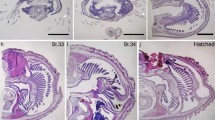Summary
By means of immunocytochemistry retinal S-antigen is selectively demonstrated in retinal photoreceptor cells of the rat and in pinealocytes of the hedgehog, rat, gerbil and cat. Brain areas surrounding the pineal organ are immunonegative. The immunoreactive material is evenly distributed in the perikarya of the cells. Occasionally, inner segments of retinal photoreceptors and processes of pinealocytes are also stained. The outer segments of retinal photoreceptors display a strong immunoreaction. In both pinealocytes and retinal photoreceptors the intensity of the immunoreaction varied considerably among individual cells.
The immunocytochemical demonstration of retinal S-antigen in mammalian pinealocytes indicates that these cells still bear characteristics of photoreceptors. This finding is in accord with the concept that mammalian pinealocytes are derived from pineal photoreceptor cells of poikilothermic vertebrates.
Similar content being viewed by others
References
Bownds D, Dawes J, Miller J, Stahlman M (1972) Phosphorylation of frog photoreceptor membranes induced by light. Nature (London) New Biol 237:125–127
Collin JP (1971) Differentiation and regression of the cells of the sensory line in the epiphysis cerebri. In: Wolstenholme GEW, Knight J (eds) The pineal gland. Churchill-Livingstone, Edinburgh and London, pp 79–125
Collin JP, Oksche A (1981) Structural and functional relationships in the nonmammalian pineal organ. In: Reiter RJ (ed) The pineal gland. Vol. I. CRC Press, Boca Raton, pp 27–47
Dodt E (1973) The parietal eye (pineal and parapineal organs) of lower vertebrates. In: Jung R (ed) Handbook of sensory physiology. Vol. VIII/3B. Springer, Berlin New York, pp 113–140
Dodt E, Heerd E (1962) Mode of action of pineal nerve fibers in frogs. J Neurophysiol 25:405–429
Faure JP (1980) Autoimmunity and the retina. Curr Top Eye Res 2:216–302
Frank RN, Buzney SM (1975) Mechanism and specificity of rhodopsin phosphorylation. Biochemistry 14:5110–5117
Frisch K von (1911) Beiträge zur Physiologie der Pigmentzellen in der Fischhaut. Pfluegers Arch ges Physiol 138:319–387
Kalsow CM, Wacker WB (1973) Localization of a uveitogenic soluble retinal antigen in the normal guinea pig eye by an indirect fluorescent antibody technique. Int Arch Allergy 44:11–20
Kalsow CM, Wacker WB (1977) Pineal reactivity of anti-retina sera. Invest Ophthalmol Visual Sci 16:181–184
Klein DC, Jacobwitz D, Mochizuki M, Stein P, Batelle B, Gery I Retinal S-antigen in the rat pineal gland: distribution and regulation (submitted)
Korf HW, Vigh-Teichmann I (1984) Sensory and central nervous elements in the avian pineal organ. Ophthalmic Res 16:96–101
Kühn H, Dreyer WJ (1972) Light dependent phosphorylation of rhodopsin by ATP. FEBS-Lett 20:1–6
Meissl H, Dodt E (1981) Comparative physiology of pineal photoreceptor organs. Dev Endocrinol 14:61–80
Möller W (1976) Paraffinum liquidum in einer Intermediumkombination für die Paraffineinbettung. Mikroskopie 32:100–104
Møller M, Glistrup OV, Olsen W (1983) Contrast enhancement of the brownish horseradish peroxidase-activated 3,3′-diaminobenzidine tetrahydrochloride reaction product in black and white photomicrography by the use of interference filters. J Histochem Cytochem 32:37–42
Oksche A (1971) Sensory and glandular elements of the pineal organ. In: Wolstenholme GEW, Knight J (eds) The pineal gland. Churchill-Livingstone, Edinburgh and London, pp 127–146
Oksche A (1984) Evolution of the pineal complex: correlation of structure and function. Ophthalmic Res 16:88–95
Romeis B (1968) Mikroskopische Technik. Oldenbourg, München, Wien
Shichi H (1981) Possible identity of experimental uveitogenic antigen (S-antigen) with rhodopsin kinase. Jpn J Ophthalmol 24:306 (1981)
Shichi H, Somers RL (1978) Light-dependent phosphorylation of rhodopsin. Purification and properties of rhodopsin kinase. J Biol Chem 253:7040–7046
Shichi H, Yamanoto K, Somers RL (1984) GTP binding protein: properties and lack of activation by phosphorylated rhodopsin. Vision Res (in press)
Sitaramayya A, Liebman PA (1983) Phosphorylation of rhodopsin and quenching of cyclic GMP phosphodiesterase activation by ATP at weak bleaches. J Biol Chem 258:12106–12109
Sitaramayya A, Virmaux M, Mandel P (1977) On a soluble system for studying light activation of rod outer segment cyclic GMP phosphodiesterase. Neurochem Res 2:1–10
Somers RL, Klein DC (1984) Rhodopsin kinase activity in the mammalian pineal gland and other tissues. Science (in press)
Sternberger LA (1979) Immunocytochemistry. John Wiley-Sons, New York Chichester Brisbane Toronto
Veen Th van, Elofson R, Hartwig HG, Gery I, Mochizuki M, Klein DC (1984) The retinal S-antigen: animal photoreceptor marker? Science (submitted)
Vigh B, Vigh-Teichmann I (1981) Light- and electron-microscopic demonstration of immunoreactive opsin in the pinealocytes of various vertebrates. Cell Tissue Res 221:451–463
Vigh-Teichmann I, Korf HW, Oksche A, Vigh B (1982) Opsinimmunoreactive outer segments and acetylcholinesterase positive neurons in the pineal complex of Phoxinus phoxinus (Teleostei, Cyprinidae). Cell Tissue Res 227:351–370
Vigh-Teichmann I, Korf HW, Nürnberger F, Oksche A, Vigh B, Olsson R (1983) Opsin-immunoreactive outer segments in the pineal and parapineal organs of the lamprey (Lampetra fluviatilis), the eel (Anguilla anguilla) and the rainbow trout (Salmogair dneri). Cell Tissue Res 230:289–307
Zigler JS, Mochizuki M, Kuwabara T, Gery I (1984) Purification of retinal S-antigen to homogenity by the criterion of gel electrophoresis silver stain. Invest Ophthal Vis Sci 259:77–81
Author information
Authors and Affiliations
Additional information
Supported by grants from the Deutsche Forschungsgemeinschaft to H.W.K. (Ko 758/2–2; 2–4) and the Deutscher Akademischer Austauschdienst to M.M.
The authors are greatly indebted to Professor A. Oksche for critical reading of the manuscript.
Rights and permissions
About this article
Cite this article
Korf, HW., Møller, M., Gery, I. et al. Immunocytochemical demonstration of retinal S-antigen in the pineal organ of four mammalian species. Cell Tissue Res. 239, 81–85 (1985). https://doi.org/10.1007/BF00214906
Accepted:
Issue Date:
DOI: https://doi.org/10.1007/BF00214906




